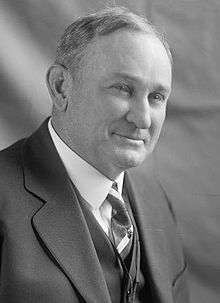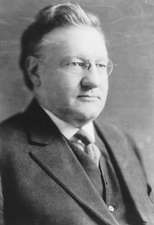1932 United States Senate elections
The United States Senate elections of 1932 coincided with Democrat Franklin D. Roosevelt's crushing defeat of incumbent Herbert Hoover in the presidential election. With the Hoover administration widely blamed for the Great Depression, Republicans lost twelve seats and control of the chamber.
| ||||||||||||||||||||||||||||||||||||||||||||||||||||||||
33 of the 96 seats in the United States Senate 49 seats needed for a majority | ||||||||||||||||||||||||||||||||||||||||||||||||||||||||
|---|---|---|---|---|---|---|---|---|---|---|---|---|---|---|---|---|---|---|---|---|---|---|---|---|---|---|---|---|---|---|---|---|---|---|---|---|---|---|---|---|---|---|---|---|---|---|---|---|---|---|---|---|---|---|---|---|
| ||||||||||||||||||||||||||||||||||||||||||||||||||||||||
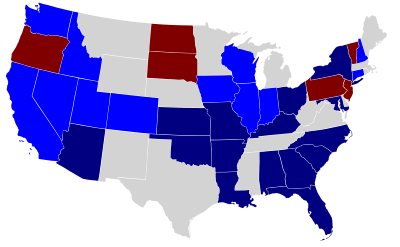 Results of the elections: Democratic gain Democratic hold Republican hold No election | ||||||||||||||||||||||||||||||||||||||||||||||||||||||||
| ||||||||||||||||||||||||||||||||||||||||||||||||||||||||
This was the first time since the 1920 elections that the victorious party defended all of their own seats and achieved a pickup in the double-digits. Senator Reed Smoot (R-UT) lost re-election: although economists disagree by how much, the consensus view among economists and economic historians is that "The passage of [his] Smoot-Hawley tariff exacerbated the Great Depression."[2]
Gains and losses
Incumbents who lost renomination
Democrats took three seats from Republican incumbents:
- California: Two-term Republican Samuel M. Shortridge lost renomination to Tallant Tubbs, who in turn, lost the general election to Democrat William G. McAdoo.
- Iowa: One-term Republican Smith W. Brookhart lost renomination to Henry Field, who in turn, lost the general election to Democrat Richard L. Murphy.
- Wisconsin: One-term Republican John J. Blaine lost renomination to John B. Chapple, who in turn, lost the general election to Democrat F. Ryan Duffy.
Incumbents who lost re-election
Democrats defeated eight Republican incumbents:
- Connecticut: Two-term Republican Hiram Bingham lost to Democratic challenger, Augustine Lonergan.
- Idaho: One-term Republican John Thomas lost to Democratic challenger, James Pope.
- Illinois: One-term Republican Otis F. Glenn lost to Democratic challenger, William H. Dieterich.
- Indiana: Three-term Republican James E. Watson lost to Democratic challenger, Frederick Van Nuys.
- Nevada: Two-term Republican Tasker L. Oddie lost to Democratic challenger, Patrick A. McCarran.
- New Hampshire: Three-term Republican George H. Moses lost to Democratic challenger Fred H. Brown.
- Utah: Five-term Republican Reed Smoot lost to Democratic challenger Elbert D. Thomas.
- Washington: Four-term Republican Wesley L. Jones lost to Democratic challenger Homer T. Bone.
Milestones
- First election in which a Senate leader lost re-election: Majority Leader James E. Watson (R-IN)
- First woman to be elected to a full term in the Senate: Hattie Caraway (D-AR)
- Last Democrat (as of 2020) to be elected from Kansas: George McGill (D-KS)
Change in composition
After the January special election
| D1 | D2 | D3 | D4 | D5 | D6 | D7 | D8 | ||
| D18 | D17 | D16 | D15 | D14 | D13 | D12 | D11 | D10 | D9 |
| D19 | D20 | D21 | D22 | D23 | D24 | D25 | D26 | D27 | D28 |
| D38 | D37 | D36 | D35 | D34 | D33 | D32 | D31 | D30 | D29 |
| D39 | D40 | D41 | D42 | D43 | D44 | D45 | D46 | D47 Ark. (sp) Elected[lower-alpha 2] |
FL1 |
| Plurality → | R48 | ||||||||
| R39 | R40 | R41 | R42 | R43 | R44 | R45 | R46 | R47 | |
| R38 | R37 | R36 | R35 | R34 | R33 | R32 | R31 | R30 | R29 |
| R19 | R20 | R21 | R22 | R23 | R24 | R25 | R26 | R27 | R28 |
| R18 | R17 | R16 | R15 | R14 | R13 | R12 | R11 | R10 | R9 |
| R1 | R2 | R3 | R4 | R5 | R6 | R7 | R8 | ||
Before the November elections
| D1 | D2 | D3 | D4 | D5 | D6 | D7 | D8 | |||
| D18 | D17 | D16 | D15 | D14 | D13 | D12 | D11 | D10 | D9 | |
| D19 | D20 | D21 | D22 | D23 | D24 | D25 | D26 | D27 | D28 | |
| D38 Ky. Ran |
D37 Kan. Ran |
D36 Ga. Ran |
D35 Fla. Ran |
D34 Ark. Ran |
D33 Ariz. Ran |
D32 Ala. Ran |
D31 | D30 | D29 | |
| D39 La. Ran |
D40 Md. Ran |
D41 N.Y. Ran |
D42 N.C. Ran |
D43 Ohio Ran |
D44 Okla. Ran |
D45 S.C. Ran |
D46 Colo. (reg) Retired
|
D47 Mo. Retired |
FL1 | |
| Plurality → | R48 Wisc. Ran | |||||||||
| R39 N.H. Ran |
R40 N.J. (sp) Ran |
R41 N.D. Ran |
R42 Ore. Ran |
R43 Pa. Ran |
R44 S.D. Ran |
R45 Utah Ran |
R46 Vt. Ran |
R47 Wash. Ran | ||
| R38 Nev. Ran |
R37 Iowa Ran |
R36 Ind. Ran |
R35 Ill. Ran |
R34 Idaho Ran |
R33 Conn. Ran |
R32 Calif. Ran |
R31 | R30 | R29 | |
| R19 | R20 | R21 | R22 | R23 | R24 | R25 | R26 | R27 | R28 | |
| R18 | R17 | R16 | R15 | R14 | R13 | R12 | R11 | R10 | R9 | |
| R1 | R2 | R3 | R4 | R5 | R6 | R7 | R8 | |||
Result of the November elections
| D1 | D2 | D3 | D4 | D5 | D6 | D7 | D8 | |||
| D18 | D17 | D16 | D15 | D14 | D13 | D12 | D11 | D10 | D9 | |
| D19 | D20 | D21 | D22 | D23 | D24 | D25 | D26 | D27 | D28 | |
| D38 Ky. Re-elected |
D37 Kan. Re-elected |
D36 Ga. Re-elected |
D35 Fla. Re-elected |
D34 Ark. Re-elected |
D33 Ariz. Re-elected |
D32 Ala. Re-elected |
D31 | D30 | D29 | |
| D39 Md. Re-elected |
D40 N.Y. Re-elected |
D41 Ohio Re-elected |
D42 Okla. Re-elected |
D43 S.C. Re-elected |
D44 Colo. (reg) Hold[lower-alpha 3]
|
D45 La. Hold |
D46 Mo. Hold |
D47 N.C. (reg) & N.C. (sp) Hold |
D48 Calif. Gain | |
| Majority → | D49 Conn. Gain | |||||||||
| D58 Wisc. Gain |
D57 Wash. Gain |
D56 Utah Gain |
D55 N.H. Gain |
D54 Nev. Gain |
D53 Iowa Gain |
D52 Ind. Gain |
D51 Ill. Gain |
D50 Idaho Gain | ||
| FL1 | R37 Vt. Re-elected |
R36 S.D. Re-elected |
R35 Pa. Re-elected |
R34 Ore. Re-elected |
R33 N.D. Re-elected |
R32 N.J. (sp) Elected[lower-alpha 2] |
R31 | R30 | R29 | |
| R19 | R20 | R21 | R22 | R23 | R24 | R25 | R26 | R27 | R28 | |
| R18 | R17 | R16 | R15 | R14 | R13 | R12 | R11 | R10 | R9 | |
| R1 | R2 | R3 | R4 | R5 | R6 | R7 | R8 | |||
| Key: |
|
|---|
Race summary
All races are general elections for class 3 seats, unless noted.
Elections during the 72nd Congress
In these elections, the winners were elected and seated during 1932; ordered by election date.
| State | Incumbent | Results | Candidates | ||
|---|---|---|---|---|---|
| Senator | Party | Electoral history | |||
| Arkansas (Class 3) |
Hattie Wyatt Caraway | Democratic | 1931 (Appointed) | Interim appointee elected January 12, 1932. Democratic hold. Winner was subsequently re-elected in November. |
|
| Colorado (Class 3) |
Walter Walker | Democratic | 1929 (Appointed) | Interim appointee lost election to finish the term. New senator elected November 8, 1932. Republican gain. Winner was not elected to the next term, see below. |
|
| New Jersey (Class 2) |
William Warren Barbour | Republican | 1931 (Appointed) | Interim appointee elected November 8, 1932. |
|
| North Carolina (Class 3) |
Cameron A. Morrison | Democratic | 1930 (Appointed) | Interim appointee lost nomination to finish the term. New senator elected November 8, 1932. Democratic hold. Winner was also elected to next term, see below. |
|
Elections leading to the 73rd Congress
All elections are for Class 3 seats.
| State | Incumbent | Results | Candidates | ||
|---|---|---|---|---|---|
| Senator | Party | Electoral history | |||
| Alabama | Hugo Black | Democratic | 1926 | Incumbent re-elected. |
|
| Arizona | Carl Hayden | Democratic | 1926 | Incumbent re-elected. |
|
| Arkansas | Hattie Wyatt Caraway | Democratic | 1931 (Appointed) 1932 (Special) |
Interim appointee elected. |
|
| California | Samuel M. Shortridge | Republican | 1920 1926 |
Incumbent lost renomination. New senator elected. Democratic gain. |
|
| Colorado | Walter Walker | Democratic | 1932 (Appointed) | Interim appointee retired. New senator elected. Democratic hold. Winner was not elected to finish the term, see above. |
|
| Connecticut | Hiram Bingham III | Republican | 1924 (Special) 1926 |
Incumbent lost re-election. New senator elected. Democratic gain. |
|
| Florida | Duncan U. Fletcher | Democratic | 1909 (Appointed) 1909 (Special) 1914 1920 1926 |
Incumbent re-elected. |
|
| Georgia | Walter F. George | Democratic | 1922 (Special) 1926 |
Incumbent re-elected. |
|
| Idaho | John W. Thomas | Republican | 1928 (Appointed) 1928 (Special) |
Incumbent lost re-election. New senator elected. Democratic gain. |
|
| Illinois | Otis F. Glenn | Republican | 1928 (Special) | Incumbent lost re-election. New senator elected. Democratic gain. |
|
| Indiana | James Eli Watson | Republican | 1916 (Special) 1920 1926 |
Incumbent lost re-election. New senator elected. Democratic gain. |
|
| Iowa | Smith W. Brookhart | Republican | 1926 | Incumbent lost renomination. Incumbent lost re-election as an Independent. New senator elected. Democratic gain. |
|
| Kansas | George McGill | Democratic | 1930 (Special) | Incumbent re-elected. |
|
| Kentucky | Alben W. Barkley | Democratic | 1926 | Incumbent re-elected. |
|
| Louisiana | Edwin S. Broussard | Democratic | 1920 1926 |
Incumbent lost renomination. New senator elected. Democratic hold. |
|
| Maryland | Millard Tydings | Democratic | 1926 | Incumbent re-elected. |
|
| Missouri | Harry B. Hawes | Democratic | 1926 (Special) 1926 |
Incumbent retired. New senator elected. Democratic hold. Incumbent then resigned and winner was appointed to finish the current term. |
|
| Nevada | Tasker Oddie | Republican | 1920 1926 |
Incumbent lost re-election. New senator elected. Democratic gain. |
|
| New Hampshire | George H. Moses | Republican | 1918 (Special) 1920 1926 |
Incumbent lost re-election. New senator elected. Democratic gain. |
|
| New York | Robert F. Wagner | Democratic | 1926 | Incumbent re-elected. |
|
| North Carolina | Cameron A. Morrison | Democratic | 1930 (Appointed) | Interim appointee lost nomination. New senator elected. Democratic hold. Winner was also elected to finish the current term, see above. |
|
| North Dakota | Gerald P. Nye | Republican | 1925 (Appointed) 1926 (Special) |
Incumbent re-elected. |
|
| Ohio | Robert J. Bulkley | Democratic | 1930 (Special) | Incumbent re-elected. |
|
| Oklahoma | Elmer Thomas | Democratic | 1926 | Incumbent re-elected. |
|
| Oregon | Frederick Steiwer | Republican | 1926 | Incumbent re-elected. |
|
| Pennsylvania | James J. Davis | Republican | 1930 (Special) | Incumbent re-elected. |
|
| South Carolina | Ellison D. Smith | Democratic | 1909 1914 1920 1926 |
Incumbent re-elected. |
|
| South Dakota | Peter Norbeck | Republican | 1920 1926 |
Incumbent re-elected. |
|
| Utah | Reed Smoot | Republican | 1903 1909 1914 1920 1926 |
Incumbent lost re-election. New senator elected. Democratic gain. |
|
| Vermont | Porter H. Dale | Republican | 1909 (Appointed) 1923 (Special) 1926 |
Incumbent re-elected. |
|
| Washington | Wesley Livsey Jones | Republican | 1909 1914 1920 1926 |
Incumbent lost re-election. New senator elected. Democratic gain. Incumbent then died November 19, 1932 and Elijah S. Grammer (R) was appointed to finish the current term. |
|
| Wisconsin | John J. Blaine | Republican | 1926 | Incumbent lost renomination. New senator elected. Democratic gain. |
|
Alabama
| Party | Candidate | Votes | % | |
|---|---|---|---|---|
| Democratic | Hugo Black (Incumbent) | 209,614 | 86.25% | |
| Republican | J. Theodore Johnson | 33,425 | 13.75% | |
| Majority | 176,189 | 72.50% | ||
| Turnout | 243,039 | |||
| Democratic hold | ||||
Arizona
| Party | Candidate | Votes | % | ± | |
|---|---|---|---|---|---|
| Democratic | Carl T. Hayden | 74,310 | 66.67% | ||
| Republican | Ralph H. Cameron | 35,737 | 32.06% | ||
| Socialist | Lester B. Woolever | 1,110 | 1.00% | ||
| Communist | Edward Haustgen | 306 | 0.28% | ||
| Majority | 38,573 | 34.61% | |||
| Turnout | 111,463 | ||||
| Democratic gain from Republican | Swing | ||||
Arkansas
.jpg)
There were two elections for the same seat, due to the November 6, 1931 death of two-term Democrat Thaddeus H. Caraway.
Caraway's widow, Democrat Hattie Wyatt Caraway, was appointed November 13, 1931 to continue his term.
Arkansas (Special)
| Party | Candidate | Votes | % | ||
|---|---|---|---|---|---|
| Democratic | Hattie Wyatt Caraway (Incumbent) | 31,133 | 91.62% | ||
| Independent | Rex Floyd | 1,752 | 5.16% | ||
| Independent | Sam D. Carson | 1,095 | 3.22% | ||
| Majority | |||||
| Turnout | 1.83% | ||||
| Democratic hold | |||||
Arkansas (Regular)
In May 1932, Caraway surprised Arkansas politicians by announcing that she would run for a full term in the upcoming election, joining a field already crowded with prominent candidates who had assumed she would step aside. She told reporters, "The time has passed when a woman should be placed in a position and kept there only while someone else is being groomed for the job."[9] When she was invited by Vice President Charles Curtis to preside over the Senate she took advantage of the situation to announce that she would run for reelection. Populist former Governor and Senator Huey Long of neighboring Louisiana traveled to Arkansas on a seven-day campaign swing on her behalf. She was the first female senator to preside over the body as well as the first to chair a committee (Senate Committee on Enrolled Bills).[10] Lacking any significant political backing, Caraway accepted the offer of help from Long, whose efforts to limit incomes of the wealthy and increase aid to the poor she had supported. Long was also motivated by sympathy for the widow and his ambition to extend his influence into the home state of his party rival, Senator Joseph Robinson, who had been Al Smith's vice-presidential candidate in 1928. Bringing his colorful and flamboyant campaign style to Arkansas, Long stumped the state with Caraway for a week just before the Democratic primary. He helped her to amass nearly twice as many votes as her closest opponent.[11]
Long effectively used a method to quiet crying babies at campaign stops in Arkansas to encourage voter interest:
Mrs. Caraway would never forget nor cease to laugh over the plans we made for caring for obstreperous infants in the audience so that their mothers might listen to the speeches without the crowds being disturbed. I remember when I saw her notice one of our campaigners take charge of the first baby. The child began fretting and then began to cry. One of the young men accompanying us immediately gave it a drink of water. The child quieted for a bit and resumed a whimper, whereupon the same campaign worker handed the baby an all-day sucker, which it immediately grasped and soon fell asleep. Mrs. Caraway did not understand that it was a matter of design until it had been repeated several times.[12]
Caraway went on to win the general election in November, with the accompanying victory of Franklin D. Roosevelt as U.S. President.[11]
| Party | Candidate | Votes | % | ||
|---|---|---|---|---|---|
| Democratic | Hattie Wyatt Caraway (Incumbent) | 187,994 | 89.71% | ||
| Republican | John W. White | 21,558 | 10.29% | ||
| Majority | 166,436 | 79.42% | |||
| Turnout | 209,552 | ||||
| Democratic hold | |||||
California
| Party | Candidate | Votes | % | |
|---|---|---|---|---|
| Democratic | William Gibbs McAdoo | 943,164 | 43.39% | |
| Republican | Tallant Tubbs | 669,676 | 30.81% | |
| Prohibition | Robert P. Shuler | 560,088 | 25.76% | |
| Write-In | George Ross Kirkpatrick | 466 | 0.02% | |
| None | Scattering | 440 | 0.02% | |
| Majority | 273,488 | 12.58% | ||
| Turnout | 2,173,834 | |||
| Democratic gain from Republican | ||||
Colorado
There were 2 elections November 8, 1932 for the same seat, due to the death of one-term Republican Charles W. Waterman. The primaries were held September 13, 1932.[13][14]
Colorado (Special)
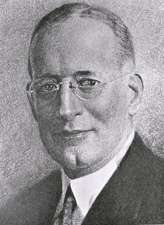
Democrat Walter Walker was appointed to continue the term, pending the special election, which he then lost.
Republican attorney Karl C. Schuyler was elected finish the term, but he lost the contemporaneous election to the next term. He died in 1933.[15]
| Party | Candidate | Votes | % | ||
|---|---|---|---|---|---|
| Republican | Karl C. Schuyler | 207,540 | 48.76% | ||
| Democratic | Walter Walker (Incumbent) | 206,475 | 48.51% | ||
| Socialist | Carle Whitehead | 11,619 | 2.73% | ||
| Majority | 1,065 | 0.25% | |||
| Turnout | 41.09% | ||||
| Republican gain from Democratic | |||||
Colorado (Regular)
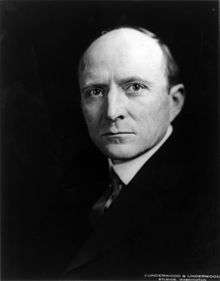
Democratic former senator Alva B. Adams was elected to start the new term that would begin in March 1933.
| Party | Candidate | Votes | % | ||
|---|---|---|---|---|---|
| Democratic | Alva B. Adams | 226,516 | 52.23% | ||
| Republican | Karl C. Schuyler | 198,519 | 45.78% | ||
| Socialist | Carle Whitehead | 8,636 | 1.99% | ||
| Farmer–Labor | Huston Hugh Marrs | 1,814 | 0.42% | ||
| Communist | Raymond D. D. Richardson | 858 | 0.20% | ||
| Majority | 27,997 | 6.42% | |||
| Turnout | 433,671 | 42.13% | |||
| Democratic hold | |||||
Adams would be re-elected once and serve until his December 1, 1941 death.
Connecticut
| Party | Candidate | Votes | % | |
|---|---|---|---|---|
| Democratic | Augustine Lonergan | 282,327 | 47.50% | |
| Republican | Hiram Bingham III (Incumbent) | 278,061 | 46.78% | |
| Socialist | Devere Allen | 19,774 | 3.33% | |
| Independent Republican | Milton Conover | 10,621 | 1.79% | |
| Socialist Labor | John L. Grennan | 2,243 | 0.38% | |
| Communist | William Secker | 1,376 | 0.23% | |
| Majority | 4,266 | 0.72% | ||
| Turnout | 594,402 | |||
| Democratic gain from Republican | ||||
Florida
| Party | Candidate | Votes | % | |
|---|---|---|---|---|
| Democratic | Duncan U. Fletcher (Incumbent) | |||
| Turnout | 204,651 | |||
| Democratic hold | ||||
Georgia
There were 2 elections, due to the death of William J. Harris.
Georgia (Regular)
_LOC_npcc.07367_(cropped).jpg)
| Party | Candidate | Votes | % | ||
|---|---|---|---|---|---|
| Democratic | Walter F. George (Incumbent) | 234,490 | 92.82% | ||
| Republican | James W. Arnold | 18,151 | 7.18% | ||
| Majority | 216,339 | 85.64% | |||
| Turnout | 252,641 | ||||
| Democratic hold | |||||
Georgia (Special)
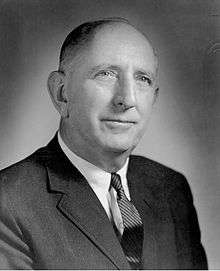
Democratic incumbent William J. Harris died April 18, 1932. Richard Russell Jr., the Democratic Governor of Georgia, appointed fellow-Democrat John S. Cohen April 25, 1932 to continue the term but Cohen was not a candidate for election.
Russell then won the September 14, 1932 Democratic primary over Charles R. Crisp, 57.72% to 42.28%.[18] Russell was then unopposed in the November 8, 1932 special election.[19]
Idaho
| Party | Candidate | Votes | % | |
|---|---|---|---|---|
| Democratic | James P. Pope | 103,020 | 55.64% | |
| Republican | John W. Thomas (Incumbent) | 78,325 | 42.30% | |
| Liberty | Oliason | 3,801 | 2.05% | |
| Majority | 24,695 | 13.34% | ||
| Turnout | 185,146 | |||
| Democratic gain from Republican | ||||
Illinois
| Party | Candidate | Votes | % | |
|---|---|---|---|---|
| Democratic | William H. Dieterich | 1,670,466 | 52.23% | |
| Republican | Otis F. Glenn (Incumbent) | 1,471,841 | 46.02% | |
| Socialist | Charles Pogorelec | 37,922 | 1.19% | |
| Communist | William E. Browder | 13,318 | 0.42% | |
| Socialist Labor | G. A. Jenning | 3,379 | 0.11% | |
| Independent | William. J. Baker | 1,209 | 0.04% | |
| None | Scattering | 16 | 0.00% | |
| Majority | 198,625 | 6.21% | ||
| Turnout | 3,198,151 | |||
| Democratic gain from Republican | ||||
Indiana
| Party | Candidate | Votes | % | |
|---|---|---|---|---|
| Democratic | Frederick Van Nuys | 870,053 | 56.80% | |
| Republican | James Eli Watson (Incumbent) | 661,750 | 43.20% | |
| Majority | 208,303 | 13.60% | ||
| Turnout | 1,531,803 | |||
| Democratic gain from Republican | ||||
Iowa
Primaries were held June 6, 1932.[20][21]
| Party | Candidate | Votes | % | ||
|---|---|---|---|---|---|
| Democratic | Richard L. Murphy | 538,422 | 54.15% | ||
| Republican | Henry Field | 399,929 | 40.22% | ||
| Progressive | Smith W. Brookhart (Incumbent) | 43,174 | 4.34% | ||
| Socialist | T. S. McCrill | 11,076 | 1.11% | ||
| Farmer–Labor | Roy M. Harrop | 1,228 | 0.12% | ||
| Communist | Peter Hunter | 467 | 0.05% | ||
| Majority | 138,493 | 13.93% | |||
| Turnout | 994,296 | 40.24% | |||
| Democratic gain from Republican | |||||
Murphy served only 3 years until his July 16, 1936 death.
Kansas
| Party | Candidate | Votes | % | |
|---|---|---|---|---|
| Democratic | George McGill | 328,992 | 45.67% | |
| Republican | Ben S. Paulsen | 302,809 | 42.03% | |
| Independent | George A. Brown | 65,583 | 9.10% | |
| Independent | J. F. W. Renker | 14,550 | 2.02% | |
| Socialist | E. Haldeman-Julius | 8,474 | 1.18% | |
| Majority | 26,183 | 3.64% | ||
| Turnout | 720,408 | |||
| Democratic gain from Republican | ||||
Kentucky
| Party | Candidate | Votes | % | |
|---|---|---|---|---|
| Democratic | Alben W. Barkley (Incumbent) | 575,077 | 59.15% | |
| Republican | Maurice H. Thatcher | 393,865 | 40.51% | |
| Socialist | W. E. Sandefur | 3,291 | 0.34% | |
| Majority | 181,212 | 18.64% | ||
| Turnout | 972,233 | |||
| Democratic hold | ||||
Louisiana
| Party | Candidate | Votes | % | |
|---|---|---|---|---|
| Democratic | John H. Overton (Incumbent) | 249,189 | 100.00% | |
| None | Scattering | 3 | 100.00% | |
| Majority | 249,186 | 100.00% | ||
| Turnout | 249,192 | |||
| Democratic hold | ||||
Maryland
| Party | Candidate | Votes | % | |
|---|---|---|---|---|
| Democratic | Millard Tydings (Incumbent) | 293,389 | 66.18% | |
| Republican | Wallace Williams | 138,536 | 31.25% | |
| Socialist | William A. Toole | 8,105 | 1.83% | |
| Socialist Labor | Noah S. Twigg | 1,859 | 0.42% | |
| Communist | Carl Bradley | 1,449 | 0.33% | |
| Majority | 154,843 | 34.93% | ||
| Turnout | 443,338 | |||
| Democratic hold | ||||
Missouri
| Party | Candidate | Votes | % | |
|---|---|---|---|---|
| Democratic | Bennett Champ Clark | 1,017,046 | 63.26% | |
| Republican | Henry Kiel | 575,174 | 35.77% | |
| Socialist | J. G. Hodges | 11,441 | 0.71% | |
| Prohibition | Herman P. Faris | 3,147 | 0.20% | |
| Communist | Pollack | 533 | 0.03% | |
| Socialist Labor | Karl L. Oberhue | 417 | 0.03% | |
| Majority | 441,872 | 27.49% | ||
| Turnout | 1,607,758 | |||
| Democratic hold | ||||
Nevada
| Party | Candidate | Votes | % | |
|---|---|---|---|---|
| Democratic | Pat McCarran | 21,398 | 52.06% | |
| Republican | Tasker Oddie (Incumbent) | 19,706 | 47.94% | |
| Majority | 1,692 | 4.12% | ||
| Turnout | 41,104 | |||
| Democratic gain from Republican | ||||
New Hampshire
| Party | Candidate | Votes | % | |
|---|---|---|---|---|
| Democratic | Fred H. Brown | 98,766 | 50.35% | |
| Republican | George H. Moses (Incumbent) | 96,649 | 49.27% | |
| Independent | Charles W. Greene | 533 | 0.27% | |
| Independent | Fred B. Chase | 228 | 0.12% | |
| Majority | 2,117 | 1.08% | ||
| Turnout | 196,176 | |||
| Democratic gain from Republican | ||||
New Jersey (Special)
| Party | Candidate | Votes | % | |
|---|---|---|---|---|
| Republican | William Warren Barbour | 741,734 | 49.61% | |
| Democratic | Percy Hamilton Stewart | 725,511 | 48.52% | |
| Socialist | Herman F. Niessner | 19,060 | 1.27% | |
| Prohibition | Esther Hill Elfeth | 2,966 | 0.20% | |
| Communist | James L. Creekmur | 2,256 | 0.15% | |
| Personal Choice | Russell Y. Page | 2,110 | 0.14% | |
| Socialist Labor | John C. Butterworth | 1,601 | 0.11% | |
| Majority | 16,223 | 1.09% | ||
| Turnout | 1,495,238 | |||
| Republican hold | ||||
New York
| Democratic ticket | Republican ticket | Socialist ticket | Law Preservation ticket | Communist ticket | Socialist Labor ticket | all | ||||||
|---|---|---|---|---|---|---|---|---|---|---|---|---|
| Robert F. Wagner | 2,532,905 | George Z. Medalie | 1,751,186 | Charles Solomon | 143,282 | D. Leigh Colvin | 74,611 | William Weinstone | 29,052 | Jeremiah D. Crowley[23] | 10,328 | 4,808,737 |
North Carolina
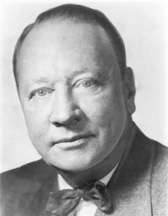
North Carolina had 2 elections for the same seat, due to the December 12, 1930 death of five-term Democrat Lee S. Overman.
North Carolina (Special)
Democratic former-Governor of North Carolina Cameron A. Morrison was appointed December 13, 1930 to continue Overman's term, pending a special election. Primaries for both parties were held June 4, 1932[24][25][26] Morrison lost the primary run-off election.
| Party | Candidate | Votes | % | ||
|---|---|---|---|---|---|
| Democratic | Robert Rice Reynolds | 485,048 | 68.66% | ||
| Republican | Jake F. Newell | 221,392 | 31.34% | ||
| Majority | 263,656 | 37.32% | |||
| Turnout | 22.28% | ||||
| Democratic hold | |||||
Reynolds was seated December 5, 1932.
North Carolina (Regular)
Primaries for both parties were held June 4, 1932[27][28] and a Democratic run-off primary was held July 2, 1932.[29] Interim appointee Cameron A. Morrison lost the primary run-off election.
| Party | Candidate | Votes | % | |
|---|---|---|---|---|
| Democratic | Robert Rice Reynolds | 482,133 | 68.62% | |
| Republican | Jake F. Newell | 220,524 | 31.38% | |
| Majority | 261,609 | 37.24% | ||
| Turnout | 702,657 | |||
| Democratic hold | ||||
Reynolds would be re-elected once and serve until his 1945 retirement.
North Dakota
44.85%
| Party | Candidate | Votes | % | |
|---|---|---|---|---|
| Republican | Gerald Nye (Incumbent) | 172,796 | 72.30% | |
| Democratic | P. W. Lanier | 65,612 | 27.45% | |
| Independent | Frank Witty | 589 | 0.25% | |
| Majority | 107184% | |||
| Turnout | 238,997 | |||
| Republican hold | ||||
Ohio
| Party | Candidate | Votes | % | |
|---|---|---|---|---|
| Democratic | Robert J. Bulkley (Incumbent) | 1,293,175 | 52.53% | |
| Republican | Gilbert Bettman | 1,126,832 | 45.77% | |
| Prohibition | Frank M. Mecartney | 34,760 | 1.41% | |
| Communist | I. O. Ford | 7,227 | 0.29% | |
| Majority | 166,343 | 6.76% | ||
| Turnout | 2,461,994 | |||
| Democratic hold | ||||
Oklahoma
| Party | Candidate | Votes | % | |
|---|---|---|---|---|
| Democratic | Elmer Thomas (Incumbent) | 426,130 | 65.61% | |
| Republican | Wirt Franklin | 218,854 | 33.70% | |
| Independent | James I. Whidden | 1,395 | 0.21% | |
| Independent | J. W. Houchin | 1,245 | 0.19% | |
| Independent | John Franing | 1,061 | 0.16% | |
| Independent | Thomas P. Hopley | 819 | 0.13% | |
| Majority | 207,276 | 31.91% | ||
| Turnout | 649,504 | |||
| Democratic hold | ||||
Oregon
| Party | Candidate | Votes | % | |
|---|---|---|---|---|
| Republican | Frederick Steiwer (Incumbent) | 186,210 | 52.72% | |
| Democratic | Walter B. Gleason | 137,237 | 38.86% | |
| Socialist | Joe A. Thomas | 12,266 | 3.47% | |
| Independent | F. E. Coulter | 11,859 | 3.36% | |
| Socialist Labor | Sverre Jacobson | 3,067 | 0.87% | |
| Communist | A. G. Krueger | 2,555 | 0.72% | |
| Majority | 48,973 | 13.86% | ||
| Turnout | 353,194 | |||
| Republican hold | ||||
Pennsylvania
| Party | Candidate | Votes | % | ± | |
|---|---|---|---|---|---|
| Republican | James J. Davis (Incumbent) | 1,375,489 | 49.46% | ||
| Democratic | Lawrence H. Rupp | 1,200,760 | 43.18% | ||
| Prohibition | Edwin J. Fithian | 106,602 | 3.83% | ||
| Socialist | William J. Van Essen | 91,456 | 3.29% | ||
| Communist | Harry M. Wicks | 6,426 | 0.23% | ||
| N/A | Others | 145 | 0.01% | ||
| Majority | 174,729 | 6.28% | {{{change}}} | ||
| Turnout | 2,780,878 | {{{change}}} | |||
| Republican hold | Swing | ||||
South Carolina
| Party | Candidate | Votes | % | ± | |
|---|---|---|---|---|---|
| Democratic | Ellison D. Smith (Incumbent) | 104,472 | 98.1% | -1.9% | |
| Republican | Clara Harrigal | 1,976 | 1.9% | +1.9% | |
| Majority | 102,496 | 96.2% | -3.8% | ||
| Turnout | 106,448 | ||||
| Democratic hold | |||||
South Dakota
| Party | Candidate | Votes | % | |
|---|---|---|---|---|
| Republican | Peter Norbeck (Incumbent) | 151,845 | 53.83% | |
| Democratic | U. S. G. Cherry | 125,731 | 44.57% | |
| Liberty | Howard Platt | 3,873 | 1.37% | |
| Independent | Oscar Luttio | 405 | 0.14% | |
| Independent | L. J. Manbeck | 238 | 0.08% | |
| Majority | 26,114 | 9.26% | ||
| Turnout | 282,092 | |||
| Republican hold | ||||
Utah
| Party | Candidate | Votes | % | |
|---|---|---|---|---|
| Democratic | Elbert D. Thomas | 116,889 | 56.66% | |
| Republican | Reed Smoot (Incumbent) | 86,046 | 41.71% | |
| Socialist | ? | 2,464 | 1.19% | |
| Communist | ? | 883 | 0.43% | |
| Majority | 30,843 | 14.94% | ||
| Turnout | 206,282 | |||
| Democratic gain from Republican | ||||
Vermont
| Party | Candidate | Votes | % | |
|---|---|---|---|---|
| Republican | Porter H. Dale (Incumbent) | 74,319 | 55.1% | |
| Democratic | Fred C. Martin | 60,455 | 44.9% | |
| Total votes | 134,774 | 100.0% | ||
| Majority | 13,864 | 10.2% | ||
| Republican hold | ||||
Washington
| Party | Candidate | Votes | % | |
|---|---|---|---|---|
| Democratic | Homer Bone | 365,939 | 60.61% | |
| Republican | Wesley Livsey Jones (Incumbent) | 197,450 | 32.70% | |
| Liberty | Frederick R. Burch | 28,859 | 4.78% | |
| Socialist | Andrew T. Hunter | 9,364 | 1.55% | |
| Communist | Alex Noral | 2,183 | 0.36% | |
| Majority | 168,489 | 27.91% | ||
| Turnout | 603,795 | |||
| Democratic gain from Republican | ||||
Wisconsin
| Party | Candidate | Votes | % | |
|---|---|---|---|---|
| Democratic | F. Ryan Duffy | 610,236 | 56.97% | |
| Republican | John B. Chapple | 387,668 | 36.19% | |
| Socialist | Emil Seidel | 65,807 | 6.14% | |
| Prohibition | Harvey A. Knapp | 4,364 | 0.41% | |
| Communist | Ray Hansborough | 2,921 | 0.27% | |
| None | Scattering | 69 | 0.00% | |
| Majority | 222,568 | 20.78% | ||
| Turnout | 1,071,065 | |||
| Democratic gain from Republican | ||||
See also
Notes
- Just after the beginning of the next Congress, a Republican senator died and a Democrat was appointed in his place
- Appointee elected
- Karl C. Schuyler (R) won the special election for the term ending in March 1933, but Alva B. Adams (D) won the general for the term beginning thereafter.
References
- "U.S. Senate: Party Division". U.S. Senate. Retrieved April 18, 2017.
- Whaples, Robert (March 1995). "Where Is There Consensus Among American Economic Historians? The Results of a Survey on Forty Propositions". The Journal of Economic History. Cambridge University Press. 55 (1): 144. doi:10.1017/S0022050700040602. JSTOR 2123771.
- "AR US Senate Special" – via OurCampaigns.com.
- "CO US Senate Special" – via OurCampaigns.com.
- "NC US Senate Special" – via OurCampaigns.com.
- "Our Campaigns – NC US Senate Race – Nov 08, 1932". www.ourcampaigns.com. Retrieved July 15, 2020.
- "Statistics of the Congressional Election of November 8, 1932" (PDF). Clerk.house.gov. Retrieved August 4, 2019.
- "AZ US Senate" – via OurCampaigns.com.
- "CARAWAY, Hattie Wyatt | US House of Representatives: History, Art & Archives". history.house.gov. Retrieved February 15, 2019.
- "Women in Congress: Statistics and Brief Overview" (PDF). Congressional Research Service. December 6, 2019. p. 13. Retrieved January 9, 2020.
- Hendricks, Nancy (April 9, 2013). Senator Hattie Caraway: An Arkansas Legacy. The History Press. ISBN 978-1-60949-968-6.
- Huey Pierce Long, Jr., Every Man a King: The Autobiography of Huey P. Long (New Orleans: National Book Club, Inc., 1933), pp. 313–314.
- "Our Campaigns – CO US Senate – D Primary Race – Sep 13, 1932". www.ourcampaigns.com. Retrieved July 15, 2020.
- "Our Campaigns – CO US Senate – R Primary Race – Sep 13, 1932". www.ourcampaigns.com. Retrieved July 15, 2020.
- "Karl C. Schuyler Died Last Night". Grand Junction Daily Sentinel. Denver, CO. Associated Press. August 1, 1933. p. 1 – via newspapers.com.
- "Our Campaigns – CO US Senate – Special Election Race – Nov 08, 1932". www.ourcampaigns.com. Retrieved July 15, 2020.
- "Our Campaigns – CO US Senate Race – Nov 08, 1932". www.ourcampaigns.com. Retrieved July 15, 2020.
- "Our Campaigns – GA US Senate – D Primary Race – Sep 14, 1932". www.ourcampaigns.com. Retrieved January 16, 2020.
- "Our Campaigns – GA US Senate Race – Nov 08, 1932". www.ourcampaigns.com. Retrieved January 16, 2020.
- "Our Campaigns – IA US Senate – D Primary Race – Jun 06, 1932". www.ourcampaigns.com.
- "Our Campaigns – IA US Senate – R Primary Race – Jun 06, 1932". www.ourcampaigns.com.
- "Our Campaigns – IA US Senate Race – Nov 08, 1932". www.ourcampaigns.com.
- Jeremiah D. Crowley, of Marcellus, ran also for State Engineer in 1910; for Lieutenant Governor in 1912, 1914 and 1920; and for Governor in 1916, 1922, 1926 and 1930
- "Our Campaigns – NC US Senate – Special D Primary Race – Jun 04, 1932". www.ourcampaigns.com. Retrieved July 15, 2020.
- "Our Campaigns – NC US Senate – Special R Primary Race – Jun 04, 1932". www.ourcampaigns.com. Retrieved July 15, 2020.
- "Our Campaigns – NC US Senate – Special D Runoff Race – Jul 02, 1932". www.ourcampaigns.com. Retrieved July 15, 2020.
- "Our Campaigns – NC US Senate – D Primary Race – Jun 04, 1932". www.ourcampaigns.com. Retrieved July 15, 2020.
- "Our Campaigns – NC US Senate – R Primary Race – Jun 04, 1932". www.ourcampaigns.com. Retrieved July 15, 2020.
- "Our Campaigns – NC US Senate – D Runoff Race – Jul 02, 1932". www.ourcampaigns.com. Retrieved July 15, 2020.
- "Statistics of the Congressional and Presidential Election of November 8, 1932" (PDF). Office of the Clerk of the U.S. House. Retrieved July 8, 2014.
- "General Election Results – U.S. Senator – 1914–2014" (PDF). Office of the Vermont Secretary of State. Retrieved June 17, 2015.
